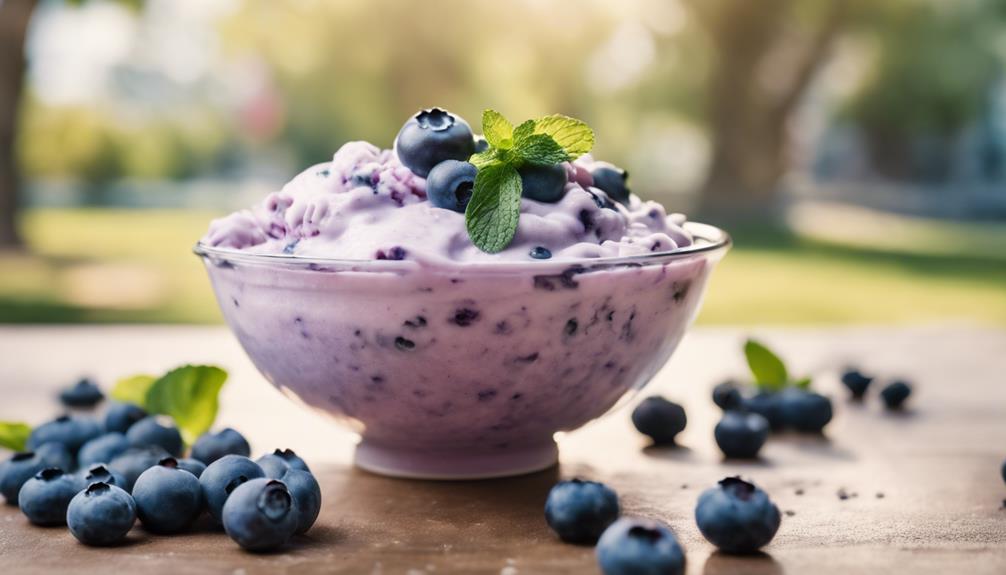If you’re in search of a refreshing indulgence, blueberry frozen yogurt is the way to go! Simply combine 3.5 cups of frozen blueberries, 2/3 cup of low-fat plain yogurt, and 2.5 tablespoons of maple syrup. Blend these ingredients until smooth, then refrigerate the mixture before churning in an ice cream maker for approximately 25 minutes. For a silkier texture, strain the blueberry mixture before freezing for 30-45 minutes to achieve that ideal soft-serve consistency. This healthier alternative not only satisfies your sweet cravings but is also low in calories. Stay tuned for more tips and variations to elevate your yogurt experience!
Key Takeaways
- Combine 3.5 cups of blueberries, 2/3 cup of yogurt, and 2.5 tablespoons of maple syrup for a delicious base.
- Add 1 tablespoon of lemon juice to enhance flavor and balance sweetness in your frozen yogurt.
- Blend ingredients until smooth; for soft-serve, serve immediately or freeze for 30-45 minutes for firmer texture.
- Use an ice cream maker for about 25 minutes to achieve a creamy consistency.
Overview of Blueberry Frozen Yogurt
Blueberry frozen yogurt is a delightful and healthy dessert that combines the vibrant flavors of blueberries with creamy yogurt for a revitalizing treat. This invigorating summer treat is perfect for those hot days when you crave something cool and satisfying. The recipe is simple and versatile, allowing you to use fresh blueberries or frozen ones based on what you have available.
To create this delicious dessert, you'll simmer the blueberries with sweeteners and a splash of citrus juice, which enhances the flavor and adds a tangy twist. Once you've created a flavorful blueberry base, you'll blend it with a chilled yogurt mixture, ensuring that every scoop is packed with taste. The result is a creamy frozen yogurt that not only satisfies your sweet tooth but also provides health benefits.
Nutritionally, blueberry frozen yogurt is a smart alternative to traditional ice cream. Each serving typically contains around 76-139 calories, depending on your choices of sweeteners and yogurt. So, whether you're enjoying a bowl on a sunny afternoon or serving it at a gathering, this blueberry frozen yogurt is a treat you can feel good about indulging in.
Ingredients Needed

To whip up your blueberry frozen yogurt, you'll need a handful of essential ingredients.
You'll also find there are plenty of tasty substitutions and variations to explore.
Plus, we can't forget to highlight the nutritional benefits that come with these ingredients!
Essential Ingredients Overview
For a delicious blueberry frozen yogurt, you'll need 3.5 cups of frozen blueberries, 2/3 cup of low-fat plain yogurt, 2.5 tablespoons of maple syrup, and 1 tablespoon of lemon juice. These ingredients are essential for creating a revitalizing and creamy frozen yogurt recipe that you'll love. The frozen blueberries provide a burst of flavor and vibrant color, while the low-fat yogurt gives it a smooth texture.
Maple syrup adds the perfect amount of sweetness, but feel free to adjust it based on the natural sweetness of your blueberries. If you're looking for a creamier texture, you might want to swap the low-fat yogurt for Greek yogurt or whole milk yogurt. The tablespoon of lemon juice not only enhances the overall flavor but also balances the sweetness, making every bite enjoyable.
This frozen yogurt recipe is versatile, allowing you to experiment with different fruit combinations. While blueberries are a fantastic choice, you can also try substituting them with strawberries, raspberries, or blackberries for a unique spin. With these essential ingredients, you're well on your way to a delightful treat!
Substitutions and Variations
Exploring substitutions and variations can elevate your blueberry frozen yogurt experience while accommodating different tastes and dietary needs.
If fresh blueberries aren't available, consider using frozen blueberries—they're often more economical and still deliver a rich blueberry flavor. For a healthier twist, swap regular yogurt for non-fat yogurt or try coconut yogurt to keep it dairy-free without sacrificing creaminess.
If you prefer a sweeter taste, maple syrup is an excellent alternative to honey or sugar, allowing you to tailor the sweetness to your liking. Don't hesitate to get creative with different fruits; incorporating strawberries or mango can lead to unique flavor combinations that will surprise your palate while maintaining the yogurt base.
Additionally, spices can take your blueberry frozen yogurt to the next level. A dash of cinnamon or a splash of vanilla extract can enhance the overall flavor depth, making each bite more enjoyable.
Nutritional Benefits Explained
Blueberry frozen yogurt isn't just a delicious treat; it packs a punch of nutritional benefits thanks to its wholesome ingredients. When you whip up this invigorating dessert, you're not only satisfying your sweet tooth but also nourishing your body with essential nutrients.
Consider these highlights of blueberry frozen yogurt:
- Antioxidants: Packed with anthocyanins, blueberries help support brain health and reduce inflammation.
- Low-calorie dessert: With around 76 calories per serving, you can indulge guilt-free.
Plus, don't forget the addition of lemon juice, which brings a burst of flavor and a healthy dose of vitamin C. This vitamin is vital for your immune function and skin health.
Preparation Instructions
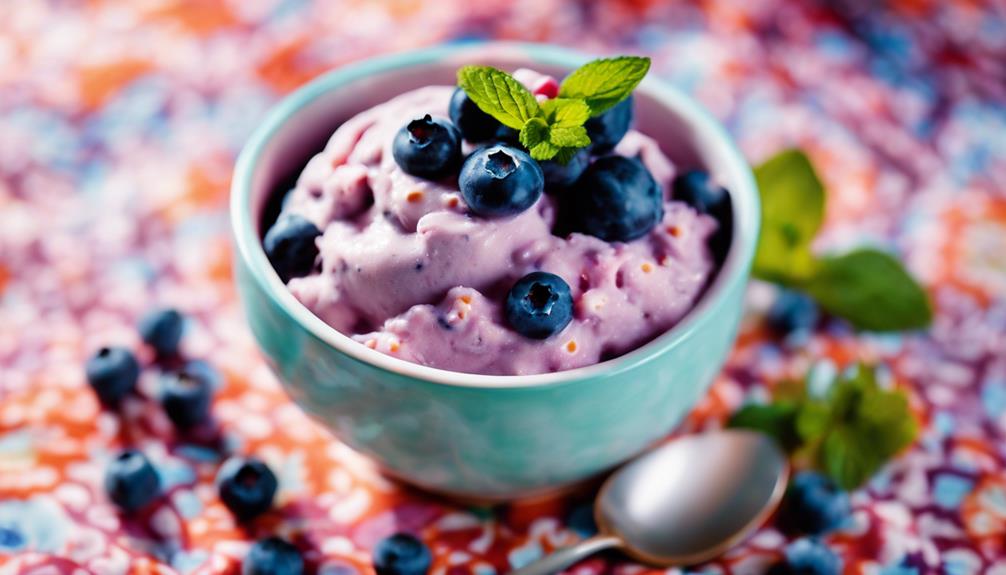
When you're ready to make your blueberry frozen yogurt, start by preparing your ingredients and blending them together smoothly.
Pay attention to the blending and mixing techniques to achieve the perfect consistency.
Ingredient Preparation Steps
Start by washing and sorting 3 cups of fresh or frozen blueberries, making sure to remove any stems or damaged fruit.
Once you've got your berries ready, grab a medium saucepan and combine the blueberries with 3 tablespoons of lemon juice, 3/4 to 1 cup of sugar, 1/4 teaspoon of salt, and 1/8 teaspoon of cinnamon. Heat the mixture over medium heat until the sugar dissolves and the blueberries are nicely mashed.
Next, let the blueberry mixture cool for about 10 minutes. Strain it through a mesh strainer to remove the skins, giving you a smoother texture.
Now, mix the strained blueberry syrup with 1.5 cups of full-fat yogurt and 1/2 cup of whole milk until fully incorporated.
Chill the mixture in the refrigerator, then it's time to process it in your ice cream maker for about 25 minutes. If you prefer a firmer texture, freeze the mixture for 30-45 minutes.
Imagine the vibrant colors and delightful flavors:
- Plump, juicy blueberries
- Creamy, velvety yogurt
You're one step closer to enjoying your blueberry frozen treat!
Blending and Mixing Techniques
Combine all the ingredients—blueberries, yogurt, sweetener, and lemon juice—in a food processor to achieve a smooth blend.
Blend until smooth, ensuring there are no chunks of fruit left, which will give you that desired creamy texture. If you prefer a soft-serve consistency, serve immediately after blending. This way, you can enjoy a delightful, creamy experience straight from the processor.
For a firmer texture, freeze the blended mixture for about 30 to 45 minutes. While it's freezing, monitor closely to prevent it from becoming too solid. You want it to be just right, so check it occasionally.
Once it's reached your preferred firmness, take it out and allow the frozen yogurt to sit at room temperature for a few minutes. This will make it easier to scoop, ensuring you don't compromise on texture when serving.
Freezing and Serving Tips
To achieve the perfect serving temperature, freeze your blueberry yogurt mixture for 30 to 45 minutes, checking it frequently to make sure it doesn't become too solid. This timing helps you reach that delightful soft-serve consistency without turning your frozen yogurt into a solid block.
If you prefer a firmer texture, you can freeze it for up to 1 hour, but be cautious of over-freezing.
Before serving, let the yogurt sit at room temperature for a few minutes. This little trick makes scooping much easier and guarantees a smooth, creamy texture.
Here are some tips for the best experience:
- Serve in chilled bowls to keep your frozen yogurt cooler longer.
- Top with fresh blueberries or a drizzle of honey for added flavor.
If you have any leftovers, store them in a sealed container in the freezer for up to a month. Just remember, the texture may change upon re-freezing, so dig in and savor your homemade blueberry frozen yogurt right away!
Freezing Guidelines
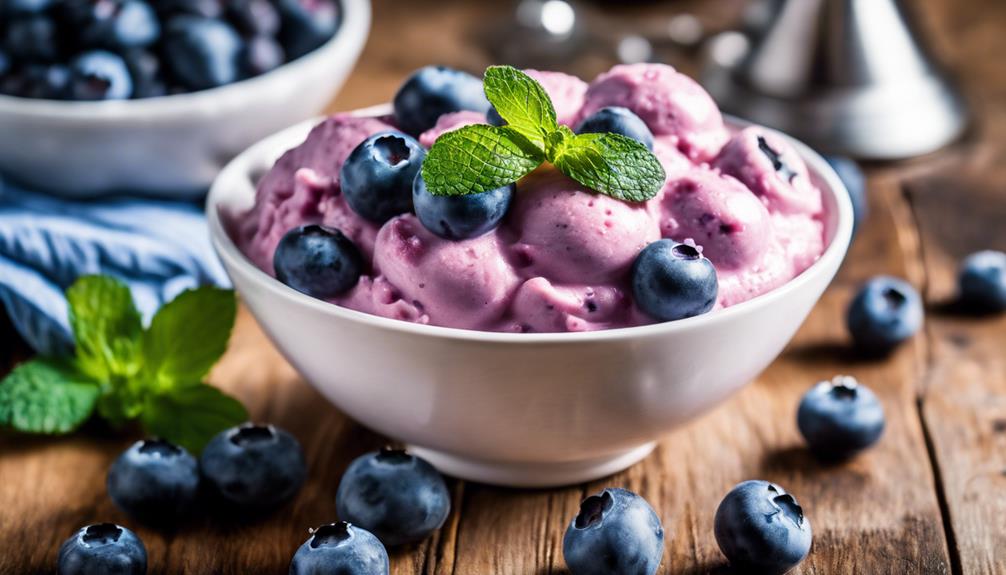
When freezing blueberry yogurt, keep an eye on the time to guarantee it remains creamy and scoopable. To achieve the best texture, aim to freeze your yogurt for no more than 30-45 minutes. If you let it freeze longer, it'll turn into a solid block, making it difficult to scoop. Natural pectin in blueberries can also affect the texture if frozen for too long, so monitor that time closely.
If you're planning to store your frozen yogurt, transfer it to a sealed container. This helps prevent freezer burn and preserves its delicious flavor for up to one month. When you're ready to serve, allow the frozen yogurt to sit at room temperature for a few minutes; this will improve its scoopability.
If you notice the mixture becomes crumbly when you take it out, don't worry! Just re-spin it in an ice cream maker or food processor to restore that creamy texture before you serve it.
Follow these guidelines, and you'll have a delightful blueberry frozen yogurt that's perfect for any occasion!
Nutritional Information

Understanding the nutritional benefits of blueberry frozen yogurt can help you enjoy this delicious treat while maintaining a balanced diet. With its low calorie count and satisfying ingredients, it's a great option for a healthy dessert.
Here's what you can expect in each serving of blueberry frozen yogurt:
- 139 calories: A guilt-free treat that won't derail your diet.
- 11 grams of protein: Supports your dietary protein goals, helping you feel full and satisfied.
In addition, this frozen yogurt contains only about 0.5 grams of fat, making it a heart-healthy choice.
The 12 grams of carbohydrates mainly come from the natural sugars found in blueberries, offering a revitalizing sweetness without excessive added sugars.
Tips for Best Results
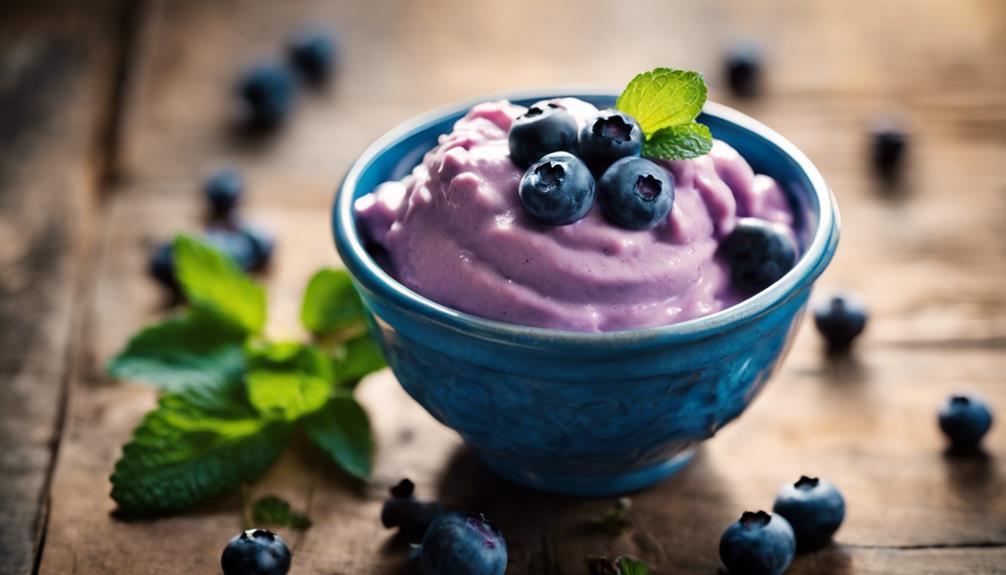
Chilling all ingredients, including yogurt and blueberries, beforehand guarantees your frozen yogurt achieves the best texture and flavor.
Start by ensuring the blueberries are fresh and sweet; you can adjust the sweetness of your mixture by varying the amount of honey or maple syrup based on your taste and the natural sweetness of your blueberries.
For an ultra-smooth consistency, strain the blueberry mixture after cooking to eliminate skins and seeds before combining it with the yogurt.
If you're using an ice cream maker, churn the mixture for about 25 minutes to incorporate air and achieve that creamy texture. For a firmer consistency, transfer the churned mixture to the freezer for an additional hour.
Keep an eye on the freezing time; if you plan to consume your frozen yogurt right away, limit the freezing time to 30-45 minutes. Extending the freezing duration can result in a solid block, which isn't ideal.
Following these tips will help you create a delicious blueberry frozen yogurt that's perfect for any occasion!
Customization Options
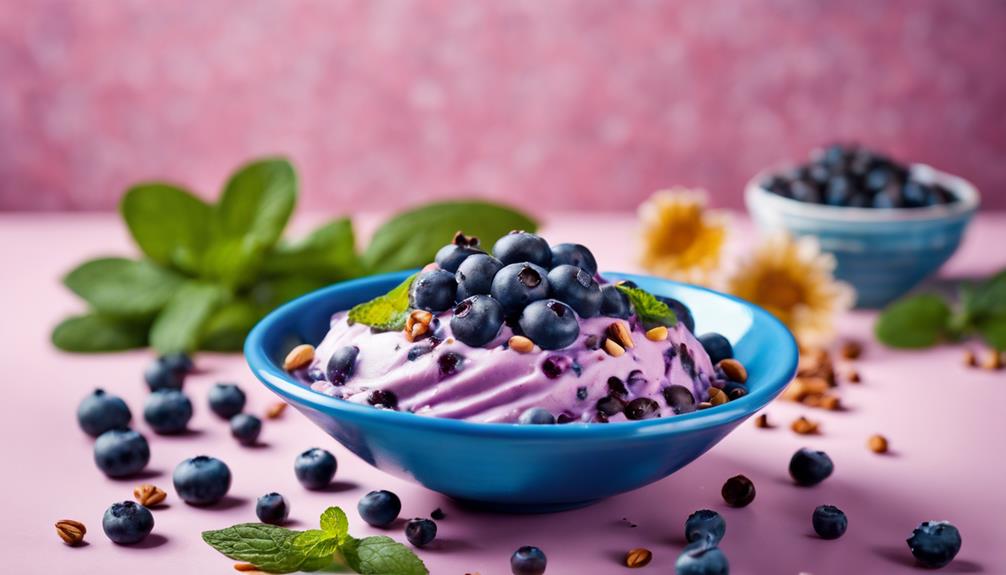
You can easily customize your blueberry frozen yogurt to suit your taste by swapping out fruits, adjusting sweetness, and adding unique flavors. This way, you can create a treat that's uniquely yours! Here are some fun customization options to contemplate:
- Substitute blueberries with strawberries, raspberries, or mangoes for new flavor profiles.
- Adjust the sweetness by varying the amount of maple syrup or honey to fit your personal preference.
For a richer, creamier texture, opt for whole milk yogurt or Greek yogurt instead of low-fat options. This will guarantee your blueberry frozen yogurt is smooth and indulgent.
Don't forget about toppings! Experiment with granola, fresh berries, or shredded coconut to add texture and elevate the overall experience.
With these customization options, your frozen yogurt can be a delightful reflection of your taste. Enjoy the process of creating a delicious and invigorating dessert that's just right for you!
Reader Feedback and Interactions
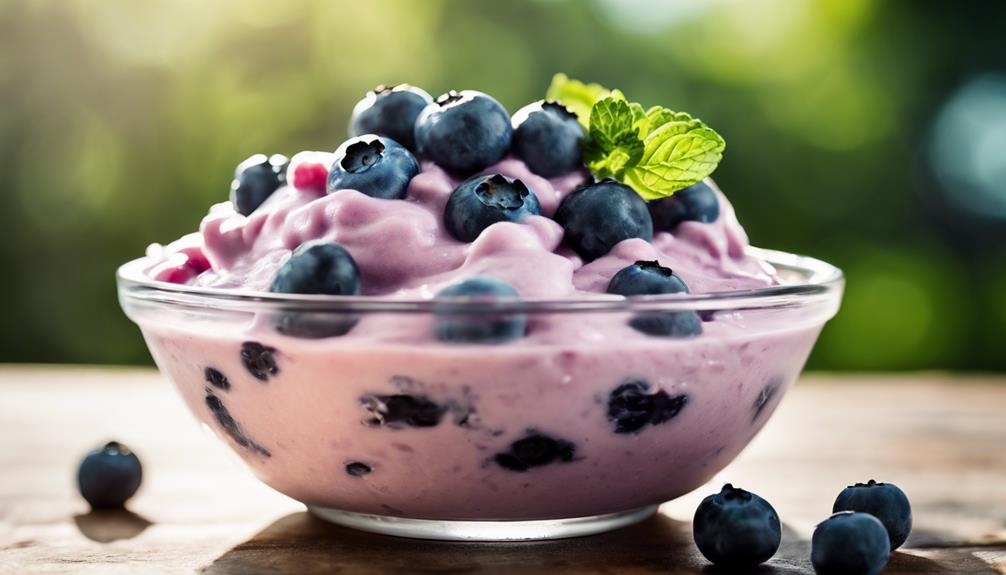
Reader feedback on blueberry frozen yogurt recipes showcases a vibrant community enthusiastic to share tips, experiences, and modifications that enhance this delightful treat. Many users rave about the delicious flavor of blueberries and the ease of preparation, making this recipe a family favorite.
You'll often see comments highlighting the importance of using an ice cream maker for achieving that perfect creamy consistency. However, if you don't own one, don't worry! A food processor can be a great alternative, and users have successfully shared their experiences using it to create a delightful texture.
People love discussing their favorite substitutions, from swapping out blueberries for other fruits to adjusting sweeteners to fit dietary needs. This adaptability is a big part of why the recipe looks so appealing in various forms.
Additionally, readers often emphasize the significance of proper mixing techniques, as skipping the churning step can lead to an icy texture. Engaging in this community allows you to share your personal stories and modifications, fostering a supportive atmosphere where everyone can enjoy this revitalizing treat together.
Frequently Asked Questions
How Do You Eat Frozen Blueberries in Yogurt?
To eat frozen blueberries in yogurt, let them thaw slightly for a few minutes. Then, mix them into the yogurt for added flavor and sweetness. You might even drizzle honey or sprinkle cinnamon for extra taste!
Is Blueberry Yogurt Good for You?
Imagine a treasure trove of nutrients! Blueberry yogurt's packed with antioxidants and protein, supporting heart health and muscle maintenance. Its natural sweetness and low calories make it a deliciously healthy choice for your diet.
Why Did Frozen Yogurt Get Popular?
Frozen yogurt became popular because it offers a healthier, customizable dessert option. With lower fat content, probiotic benefits, and a fun self-serve experience, it appealed to health-conscious consumers looking for guilt-free indulgence.
What Happens When You Mix Frozen Blueberries and Milk?
When you mix frozen blueberries and milk, you create a sweet, fruity blend. The blueberries release antioxidants and vitamins, enhancing nutrition and altering texture based on the milk's fat content, resulting in a delicious drink.
Conclusion
To sum up, making blueberry frozen yogurt isn't only simple but also a delightful way to enjoy a revitalizing treat.
For instance, consider a family gathering where you whipped up this recipe—everyone loved it, and the kids even helped mix the ingredients!
With the tips and customization options provided, you can easily tailor this dessert to suit your taste.
So grab your blueberries and get started; you won't regret it!
